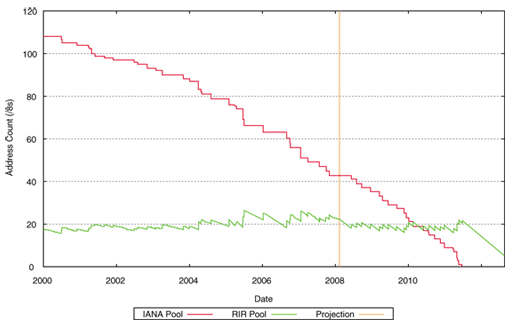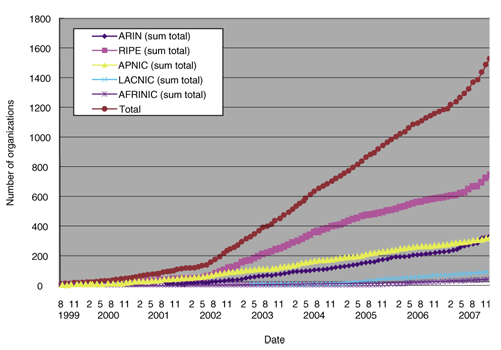 |
|||||||||||
|
|
|||||||||||
|
Global Standardization Activities Vol. 6, No. 7, pp. 39–43, July 2008. https://doi.org/10.53829/ntr200807gls Trends in IPv6 Technology: Standardization, Resource Management, and DeploymentAbstractThis article describes recent trends and activities related to the standardization, resource management, and deployment of IPv6 (Internet protocol version 6), which is seen as an effective solution to the expected shortage of IPv4 (Internet protocol version 4) addresses.
1. Shortage of IPv4 addressesThe IPv4 (Internet protocol version 4) addresses used to identify devices connected to the Internet have a fixed width of 32 bits. The worldwide expansion of the Internet has created an extremely high demand for IPv4 addresses, and there is concern that the number of available addresses will be insufficient to meet the demand. Geoff Huston of APNIC (Asia Pacific Network Information Centre), an Internet resource management organization, has presented a graph that shows the projected shortage (Fig. 1).
IP addresses, autonomous system identification numbers, and other such Internet resources are managed centrally by an organization called IANA (Internet Assigned Numbers Authority), and the distribution of those resources is delegated to five subordinate Regional Internet Registries (RIRs). APNIC, which is one of these RIRs, is responsible for the Asia and Pacific region. RIRs allocate addresses in response to requests from Internet service providers (ISPs) in each region as needed. Huston's predictions indicate that IANA will run out of IPv4 addresses in around July 2011 and that the RIRs will also one-by-one be depleted of addresses for allocation to ISPs in 2012. (That prediction reflects current address usage circumstances and is updated daily.) These circumstances have motivated the current studies for means to deal with the expected IPv4 address shortage in various parts of the world. In Japan, this matter is being discussed by research organizations under the leadership of the Ministry of Internal Affairs and Communication [1] and the JPNIC (Japan Network Information Center) [2], Japan's address registry, and other organizations. In those discussions, the introduction of IPv6 (Internet protocol version 6) is being described as the only permanent solution to the IPv4 address shortage. 2. IPv6 standardization: IETF 6man WG and v6ops WG trendsIn the IETF (Internet Engineering Task Force), the IPv6 Working Group (WG) has been working on standards for the basic specifications of IPv6. Standardization of the basic IPv6 specifications was mostly completed in 2005, so there are no on-site sessions of the IPv6 WG itself at IETF meetings; the only activity has been discussion on the mailing list. However, as progress had reached the point of studies on the introduction and practical application of IPv6, there have been proposals for a number of changes to the basic IPv6 specifications and to the Request for Comments (RFC) standardization documents decided on by the IPv6 WG. A new WG called IPv6 Maintenance (6man) was started up in September 2007. As its name indicates, the 6man WG aims to make minor revisions to the IPv6 protocol specifications and RFCs concerning address architecture and to promote the standardization status of the basic IPv6 specifications, so there will be no major changes or additions to the IPv6 specifications. The following four items raised by the charter of the 6man WG are currently being discussed to supplement and slightly revise the IPv6 basic specifications.
Standardization is mainly completed for the first three of these topics. The discussion concerning ULA-C and the already standardized unregistered unique local IPv6 unicast addresses (ULA) and differentiation with provider independent (PI) addresses has quietened down, but the issue remains unsettled and complete standardization has not been attained. In addition, although it is not in the charter, matters such as IPv6 multi-prefix control are also being discussed, and discussions on matters that go beyond the charter have begun. Broad changes in the address assignment mechanism prescribed in the IPv6 basic specifications are being proposed, changes in the basic IPv6 specifications such as the specifications concerning the mechanism for passing the default route for hosts over the network are being proposed, and new topics are coming up in accordance with the spreading use of IPv6 and the use of IPv6 by many people. 3. Reconsideration of IPv6 translator specificationsThe v6ops WG has been dealing with IPv6 operations problems and the transition from IPv4 to IPv6. As an IPv6 transition technology, NAT-PT (network address translation, protocol translation) [3] was standardized as the IPv4/IPv6 protocol translation technology by the ngtrans WG (Next Generation Transition WG), the predecessor of the v6ops WG, and that product has also been picked up. Nevertheless, according to the reasons for introducing NAT to the IPv6 network, this method has been made Historical. That leaves us with no means of direct communication between hosts that have been assigned only IPv6 addresses and hosts that have been assigned only IPv4 addresses, without going through proxies. Therefore, the v6ops WG has begun investigating technology to replace NAT-PT. In this WG, participants have presented the results of a survey concerning the situation of IPv6 use, definitions of problems, definitions of requirements, and proposals for solution scenarios for protocol translation technology. Basically, however, a two-step model of address conversion from IPv4 to IPv6 and then from IPv6 to IPv4 is being proposed rather than a single address conversion by equipment that exists between the end hosts as is done in NAT-PT. Two methods have been proposed for the first address conversion of this two-step process: performing the first conversion within the host or performing it in the user router or other device upstream of the host (Fig. 2). In such a two-step address conversion, the first address conversion is performed on the user premises, either at the home gateway or within the user terminal, even if only IPv6 addresses have been assigned, and the second address conversion is performed by the IPv6-IPv4 translator within the ISP. As a result, the use of IPv4-only terminals or applications can continue and IPv6 hosts can communicate with both IPv4 hosts and IPv6 hosts. With this method, however, communication from IPv4-only terminals or applications to hosts that have IPv6 addresses assigned is not possible, and vice versa.
Thus, there is currently no technology being proposed that will perfectly complement NAT-PT and we do not believe that any future single method can implement it. Nevertheless, we believe that it is necessary to proceed with suitable standardization that combines the technology required for the sound diffusion of IPv6 and the environment that the technology requires. 4. Trend in IPv6 address useThe numbers of organizations acquiring IPv6 addresses worldwide are presented in Fig. 3. There has been a strong increase in the use of IPv6 addresses. Taking a regional view, the number of such organizations in the APNIC region is falling behind the number for ARIN (American Registry for Internet Numbers), the registry for North America. Address acquisition by country is listed in Table 1. Japan held fourth place by country, having caught up recently to come only slightly behind the combined value for the UK and GB, as of February 2008. We thus see that use of IPv6 is proceeding in many countries around the world besides Japan.
What is clear is that for the USA in the ARIN region, application service providers such as YouTube and Google, vendors such as Intel and EMC, and general corporations such as Coca Cola and Goldman Sachs have been acquiring IPv6 addresses in addition to military and government organizations. 5. Trend in IPv6 address policyThe address policy, which specifies the rules for what kinds of organizations can acquire Internet resources, is undergoing appropriate revision. The trend in worldwide IPv6 addresses reflect an increase in organizations acquiring IPv6 addresses and accumulated experience with the use of IPv6 addresses. The policy implemented at the beginning of 2007 was stricter than before regarding the size of IP address blocks that can be acquired and the criteria for reapplication for addresses after they have been acquired. Moreover, the size of the addresses that ISPs allocate to users was changed from the former standard allocation of /48, which allowed the construction of 65,535 subnets per use, to from /64 to /48, selectable at the discretion of the ISP. Other than that, new definition and distribution of IPv6 provider-independent addresses (IPv6 PI addresses) for organizations that want small-scale redundant multihome connection to the Internet have also begun in the APNIC region, and a number of organizations have already acquired addresses. Defining those PI addresses poses the risk of increasing the number of advertised routes on the Internet. Nevertheless, because of the demand for the multihoming method being used in IPv4 to be used in IPv6 as well and because of the situation of IPv6 PI address definition in other regions, distribution for use limited to multihoming has been approved in the APNIC region. The APNIC region address policy is defined in [4]. 6. IPv6 DNS situationThere has also been steady progress in practical use of the IPv6 Internet. There has been a major development regarding what was previously a serious problem: compatibility of the system for name resolution on the Internet with IPv6. On April 4, 2008 (USA time), the AAAA record (record for registering IPv6 address information) was added to the root zone of the domain name system (DNS). When ordinary users use services on the Internet, the IP address is rarely specified directly. Instead, the destination to be accessed is specified by a text string called a domain name. The DNS is a distributed database used to convert between domain names and IP addresses. It plays an important role in today's Internet. The addition of the AAAA record resulted in the registration of IPv6 addresses in the root zone, which is the basic database for the DNS worldwide. In other words, while help from IPv4 was previously needed for DNS name resolution, name resolution is now possible even in an IPv6-only environment. (In practice, there are still DNS servers on the Internet that are not compatible with IPv6, so IPv4 is still required when it is necessary to access those DNS servers.) The JP DNS server that manages Japan's jp domain has been capable of DNS look-up by IPv6 communication since 2004, and in the future, the DNS servers of all domains will be capable of domain name look-up by IPv6 communication alone. 7. Future IPv6 standardizationThe various standards and address policies used on the Internet are being revised in a manner appropriate to the circumstances. In accordance with progress in widespread use of IPv6, an approach of continuous observation and response to services and other circumstances is important in proceeding with the revision of the standards and rules that are relevant to IPv6 in line with the circumstances of use. References
|
|||||||||||















